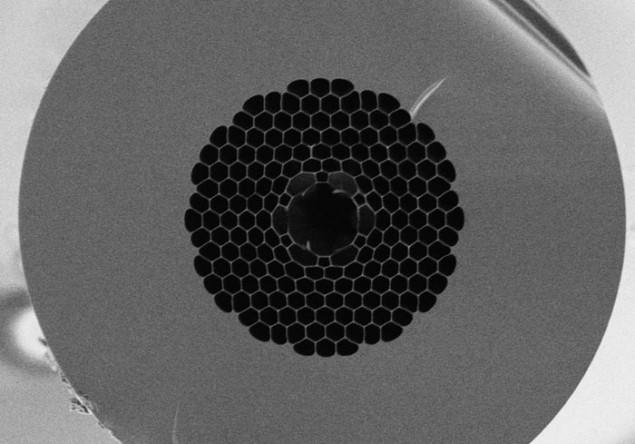
Physicists in Germany have developed a trap for micron-sized particles that relies on both laser light and heat. The “optothermal” trap, which is built around a photonic crystal fibre, puts a new twist on microparticle trapping. The technique could offer a way to make precise measurements of the thermal forces acting on tiny particles and could even be used to sort and concentrate microparticles.
For more than 20 years it has been possible to trap microscopically small objects using light. The key development came in 1986 when Arthur Ashkin, Steven Chu and others at Bell Labs in the US invented what became known as optical tweezers: focused laser light that can hold microparticles in mid-space. The phenomenon works because dielectric particles are attracted to the region of strongest electric field, which is where the laser beam is focused.
Light traps and transports
Optical tweezers are now regularly used to trap and manipulate microparticles – particularly biological microparticles, such as cells and viruses. But light isn’t the only way to trap microparticles – thermal forces, generated by light absorption, can also play a role. For instance, a laser can heat just one side of a particle so that molecules bouncing off it receive different amounts of momentum depending on the side that they strike. The effect can be used to trap or transport particles over centimetre distances in air.
Now, Oliver Schmidt, Tijmen Euser and colleagues of the Max Planck Institute for the Science of Light in Erlangen, Germany, have taken a new approach to trapping. In their device, a microparticle with diameter of about 6 μm is contained within a hollow-core, photonic-crystal fibre. This is a transparent fibre with a 100 μm outer diameter, 12 μm inner diameter and a 2D array of holes in the cladding. Laser light drives the microparticle along the fibre’s air-filled core but, when it approaches a black band drawn around the fibre, it comes to a halt of its own accord.
Thermal creep flow
The trick works because of a phenomenon known as “thermal creep flow”, which exists only very close to a surface that has a temperature gradient – that is, a hot side and a cold side. Hot molecules in the air will impart the surface with more momentum than the cold molecules, which means that the surface receives an overall force in the cold direction. In reaction, the air at the centre of the cores flows in the opposite direction – from cold to hot.
In the Max Plank group’s device, the thermal gradient is created by the microparticle’s scattering of light, which is absorbed by the black band. The resulting thermal creep drives a flow of air along the core’s surface towards the hot spot, which is balanced by a flow of air along the middle of the core in the opposite direction – away from the hot spot – creating a structure resembling a convection current. This complex series of actions effectively produces a viscous drag force that counteracts the laser’s pushing and traps the microparticle at the band.
Sorting microparticles
Schmidt and Euser point out that, unlike the previous optothermal traps, their device doesn’t require the microparticles themselves to be light-absorbing. Moreover, the radiation and viscous forces scale linearly with the laser’s power, which means that the trapping is independent of laser power. The researchers say that the trap could have applications in so-called “lab on a chip” systems in which microparticles could be moved round a tiny chip while various analyses are performed. Or, if the drawn-on bands are replaced with actual heating elements, the trap could be used to sort microparticles according to their physical properties, or to measure the thermal forces acting on them.
“Small, electrically controlled heating elements could be placed at specific locations along microfluidic channels,” the researchers say. “When switched on, the induced thermal creep flow can be used to either trap particles or to sort them. Such localized heating elements would be extremely easy to implement, not requiring any optical connections.”
Biophysicist Dieter Braun at the Ludwig Maximilians University Munich in Germany believes that for the trapping and detection of biomolecules, the fibre would need to be tuned for fluorescence imaging. But he adds that the use of hollow fibres is “very original”. Its application potential “is encouraging and should be pursued,” he says.
The research is described in Physical Review Letters.




